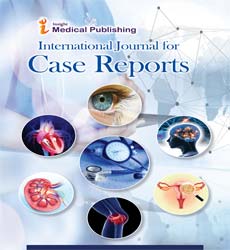Odontogenic Carcinoma with Ghost Cells
Ilhan Satman*
Faculty of Medicine, Istanbul University, Istanbul, Turkey
- *Corresponding Author:
- Ilhan Satman
Faculty of Medicine, Istanbul University, Istanbul, Turkey
E-mail: camhaymana@hotmail.com
Received Date: July 15, 2021; Accepted Date: October 19, 2021; Published Date: October 29, 2021
Citation: Satman I (2021) Odontogenic Carcinoma with Ghost Cells. Int J Case Rep Vol. 5 No: 6
Introduction
Unusual intraosseous ameloblastoma radiography findings have been described and discussed. Many radiographic features that were ambiguous on conventional radiographs were clearly visible on Cone-Beam Computed Tomography (CBCT) in the case discussed here, including an ill-defined periphery, extensive superficial buccal limited lingual extension, evident bucco-crestal expansion, and an ill-defined periphery. It was later determined that this was a diffuse midline glioma with the H3 K27M mutation. The original diagnosis was distinctive and complicated because of the nonfocal clinical presentation in the setting of communicating hydrocephalus, as well as the considerable exophytic tumour development and imaging abnormalities. As a result, this example underscores the tumor's uncommon presentation. During the COVID-19 pandemic, an adolescent was diagnosed with Influenza B infection and Kawasaki illness. An asthmatic female adolescent was admitted with acute respiratory failure needing mechanical ventilation after presenting with fever and flu-like symptoms for 7 days. She developed hemodynamic instability that was sensitive to vasoactive medications as she progressed. Antibiotic medication and supportive measures were started, which resulted in improved hemodynamics and respiratory function, although with a persistent fever and elevated inflammatory markers. She developed bilateral non-purulent conjunctivitis, hand and foot desquamation, strawberry tongue, and cervical adenopathy during her stay in the hospital, and was diagnosed with Kawasaki disease. There were no coronary changes discovered. Only the Influenza B virus was isolated using a comprehensive viral panel that included COVID-19 C-reactive protein and serology. She was diagnosed with pulmonary thromboembolism during her stay; coagulopathies were explored, and she was found to have the heterozygous factor V Leiden mutation. There could be a link between Kawasaki disease and infection. Deep vein thrombosis (DVT) is a common medical problem, although the predisposing anatomical features that may be treatable are frequently missed. As a result, early diagnosis requires a high index of clinical suspicion. To raise awareness, we present one such example of May-Thurner syndrome (MTS). Histiocytic sarcoma (HS) is an extremely rare lymphohematopoietic malignancy with mature tissue histiocyte morphological and immunophenotypic features. To our knowledge, this is the only case of an HS with synchronous cutaneous and gastrointestinal tract involvement that has been reported in the literature. The differential diagnosis was a long-term infected benign or low-grade malignant lesion based on the findings. The histopathologic diagnosis was acanthomatous ameloblastoma after an incisional biopsy. At 4 and 8 years after surgery, CBCT scans clearly showed recurrence of the lesion. These atypical radiographic features have never been linked to ameloblastoma before, and could lead to new approaches to radiographic interpretation in the future. The importance of CBCT as a complete diagnostic technique and for certain confirmation of recurrence is also highlighted in this paper. The presence of ghostcells characterises ghost cell odontogenic carcinoma (GCOC), a rare malignant tumour. It's thought to be the result of a calcifying odontogenic cyst (COC) or a dentinogenic ghost cell tumour (DGCT). Slow development, locally aggressive activity, and eventual metastasis are among its clinical and radiographic characteristics. Plain radiographs and cone-beam computed tomographic scans of a 43-year-old Thai man revealed a unilocular radiolucency with non-corticated margins surrounding an impacted left canine, as well as radiopaque foci around it [1-7].
References
- Ledesmaâ?Montes C, Gorlin RJ, Shear M, Præ´ torius F, Mosquedaâ?Taylor A, Altini M, Unni K, Paes de Almeida O, Carlosâ?Bregni R, Romero de León E, Phillips V.(2008) International collaborative study on ghost cell odontogenic tumours: calcifying cystic odontogenic tumour, dentinogenic ghost cell tumour and ghost cell odontogenic carcinoma. Journal of oral pathology & medicine. 37(5): 302-8.
- Nazaretian SP, Schenberg ME, Simpson I, Slootweg PJ.(2007) Ghost cell odontogenic carcinoma. International journal of oral and maxillofacial surgery. 36(5): 455-8.
- Motosugi U, Ogawa I, Yoda T, Abe T, Sugasawa M, Murata SI, Yasuda M, Sakurai T, Shimizu Y, Shimizu M.(2009) Ghost cell odontogenic carcinoma arising in calcifying odontogenic cyst. Annals of diagnostic pathology.13(6): 394-7.
- Zhu ZY, Chu ZG, Chen Y, Zhang WP, Lv D, Geng N, Yang MZ.(2012) Ghost cell odontogenic carcinoma arising from calcifying cystic odontogenic tumor: a case report. Korean journal of pathology.46(5):
- Remya K, Sudha S, Nair RG, Jyothi H.(2018) An unusual presentation of ghost cell odontogenic carcinoma: A case report with review of literature. Indian Journal of Dental Research. 29(2):
- da Silva WG, Dos Santos TC, Cabral MG, Azevedo RS, Pires FR.(2014) Clinicopathologic analysis and syndecan-1 and Ki-67 expression in calcifying cystic odontogenic tumors, dentinogenic ghost cell tumor, and ghost cell odontogenic carcinoma. Oral surgery, oral medicine, oral pathology and oral radiology. 117(5): 626-33.
- Loyola AM, Cardoso SV, de Faria PR, Servato JP, de Paulo LF, Eisenberg AL, Dias FL, Gomes CC, Gomez RS.(2015) Clear cell odontogenic carcinoma: report of 7 new cases and systematic review of the current knowledge. Oral surgery, oral medicine, oral pathology and oral radiology.120(4): 483-96.
Open Access Journals
- Aquaculture & Veterinary Science
- Chemistry & Chemical Sciences
- Clinical Sciences
- Engineering
- General Science
- Genetics & Molecular Biology
- Health Care & Nursing
- Immunology & Microbiology
- Materials Science
- Mathematics & Physics
- Medical Sciences
- Neurology & Psychiatry
- Oncology & Cancer Science
- Pharmaceutical Sciences
